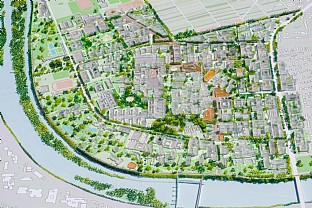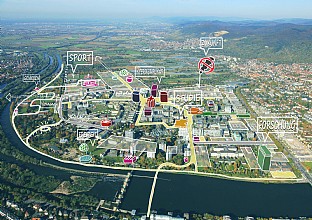The campus area Im Neuenheimer Feld is located alongside the river Neckar, near the historic centre of Heidelberg, and accommodates the natural sciences and medicine faculties. The masterplan covers an area of about 150 ha and sets the framework for the campus’ densification and expansion over the next 30 years and beyond while maintaining the crucial future flexibility and adaptability of the site.
The masterplan is developed in close collaboration with the university, city, and community of Heidelberg. The aim is to combine development potentials with upgrades of public spaces and ecological values, new urban mobility concepts and social infrastructure to create a world-class research, education, and treatment environment.
Im Neuenheimer Feld plays a special role because of its size, location, and the growing need for science to engage in interdisciplinary knowledge transfer and direct exchange with society. The campus is therefore to become an active and agile urban-integrated district that enriches the city and the Heidelberg region as a motor of economy and knowledge, while also being a good neighbour.
Climate neutral by 2050
The plan is envisioned as a cell structure, where the academic campus becomes the core, surrounded by “membrane surfaces” where the interaction with the context is enabled. The concept is to make the campus a part of the larger urban organism, by considering functional zoning, transitions, resources, and traffic flows across the city. A new traffic layout creates a larger and greener car-free inner core, a healthy campus for cyclists and pedestrians with the added benefit of reduced interference with sensitive scientific equipment.
Public space constitutes the “nervous system” of the development, connecting all areas of the campus. A central promenade and bike connection as backbone of the campus network traverses the most important places and junctions and opens the campus toward the city, the landscape and not least the currently underused riverfront. A separate green infrastructure in the form of a garden route links the existing pockets of green, improves the local microclimate, and sets the frame for student life and knowledge transfer on the campus.
The aim of the development is a climate-neutral energy supply by 2050 based on the climate protection goals for Heidelberg - 100% climate neutrality by 2050. At the same time, the quality of urban space and functionality of the campus is increased and the resilience of the site is improved through greater energy independence.






